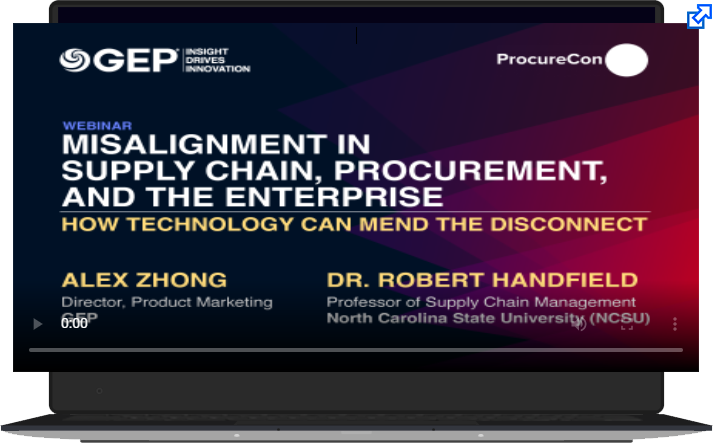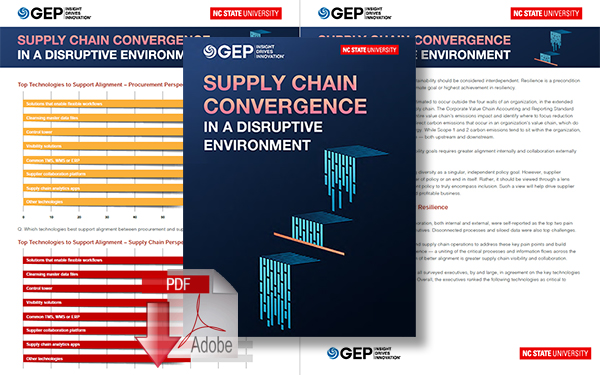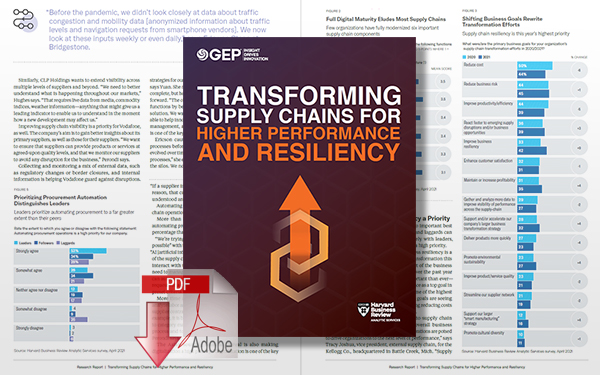Convergence is Key to Supply Chain Resilience: NC State University Research

Finding ways to counter supply chain disruption and building resilience are the top priorities for businesses today, however, many organizations have not walked the talk.
NC State University Research
- Misalignment between procurement and supply chain operations is hurting businesses the most today
- These and other gaps in organizational and supply chain processes present significant risks and result in higher costs, longer cycle times, and less resilience
- The need of the hour is to ‘converge’ critical processes, information flows, and technologies across the organization, supply chain, and extended ecosystem
Building supply chain resilience
Finding ways to counter supply chain disruption and building resilience are the top priorities for businesses today. In this endeavor, however, many organizations have not walked the talk.
In fact, there still are glaring gaps in procurement and supply chain processes that present greater risks in today’s uncertain business environment.
These gaps have been exposed in a study conducted by GEP in partnership with the Supply Chain Resource Cooperative at North Carolina State University (NCSU). The key objective of the study was to determine the strategies and priorities for procurement and supply chain professionals across a variety of industries.
What is the biggest gap?
The study found that there are several “highly concerning” points of misalignment - or gaps - in most organizations and supply chains. These gaps occur in processes, information flows, and technology, and often result in a drag on productivity, as well as present significant risks.
As many as 59% of supply chain executives surveyed rated the procurement-supply chain gap as a “major issue.” This was rated the No. 1 gap in the organization according to the study.
The warehouse and transportation gap was the second most concerning point of disconnection, while the gap between supply chain planning and execution was the third most concerning.
Executives see these gaps as posing significant problems, reporting they result in higher costs, longer cycle times, and less resilience. Specifically, 58% of supply chain executives reported that the primary gaps can result in higher costs, 47% were concerned the gaps result in longer cycle times, and 42% reported the gaps negatively impact resiliency.
Different teams, different priorities
The report also found a surprising schism in the prioritization of resilience within most organizations, with chief procurement officers (CPOs) and chief supply chain officers (CSCOs) focused on resilience as their top priority in the current environment, while mid-level and operational management hyper-focused on their traditional measurements.
For procurement managers, the central focus is on managing costs in the face of inflation, and for the supply chain, it is ensuring delivery of supply amidst shortages.
The report also delves further into internal misalignments including those around enterprise-level priorities such as sustainability. The study also revealed a surprising misalignment between business executives and chief information officers (CIOs) who appear to have differing views regarding the business’ execution needs.
Surveyed executives reported supply chain visibility and supply chain collaboration, both internal and external, were the top two major pain points – with both underlying organizational and supply chain misalignment.
Convergence is the need of the hour
The report says that enterprises need to better align their procurement and supply chain operations to address key pain points and build resiliency. And it concludes with a discussion of the need for convergence - a uniting of the critical processes, information flows, and technologies across the organization, supply chain, and extended ecosystem.
Convergence, a growing topic of conversation in C-suites and supply chains, is seen as a necessary step in closing the gaps and building greater alignment and resiliency.
OnDemand Webinar
Gartner in its 2022 report stated that 79% of large organizations are focusing on building resilience. Supply chain convergence is a bold, far-reaching strategy that fosters efficiency and is a key to that mission. Listen to GEP’s Alex Zhong and Matthew Pedersen, with John Kovac from Microsoft for expert insights on supply chain convergence. View the OnDemand Webinar here.
Webinar: Misalignment in Supply Chain, Procurement, and the Enterprise
How Technology Can Mend the Disconnect

The global pandemic and a cascading series of disruptions have fundamentally altered supply chain and procurement operations, and many companies were ill-equipped to adapt to an altered landscape. Now, new research shows that there may be an underlying misalignment in the response: a disconnect between supply chain and procurement operations, and a disconnect between these practices and the enterprise on strategic priorities.
What’s the impact, and what can be done to fix it?
Watch the webcast Misalignment in Supply Chain, Procurement and the Enterprise: How Technology Can Mend the Disconnect for the answers. Alex Zhong, GEP Director, and Dr. Robert Handfield, Professor of Supply Chain Management at North Carolina State University, will provide expert insight into the pain points organizations are facing, the roots of the problem, and how technology may mend the gap.
Key Discussion Points:
- The misaligned priorities between supply chain and procurement executives, and how they can close the gap and address pain points
- The disconnect between supply chain and procurement practices and enterprise priorities, and how they can align to meet expectations
- How collaboration technology may be able to close process gaps and improve results
Related Resources
Supply Chain Convergence in a Disruptive Environment
This paper is a must-read for supply chain and procurement leaders who are looking to fortify their supply chains with greater resilience to disruption. Download Now!
Transforming Supply Chains for Higher Performance and Resiliency
This study from Harvard Business Review Analytic Services commissioned by GEP explores the digital status quo of supply chains today, and how enterprises can and must revamp their supply chains to thrive in a never-normal world. Download Now!
More Resources from GEP
Related Article: Top 5 Supply Chain Processes That Need Better Collaboration
Article Topics
GEP News & Resources
GEP Procurement & Supply Chain Tech Trends Report 2024 How Procurment and Supply Chain Leaders Should Handle Supply Chain Disruptions Optimizing Business Outcomes by Investing in Sustainable Supply Chains and Procurement Optimizing Direct Material Sourcing with a Unified, Extensible Source-to-Pay Platform Generative AI in Procurement Navigating the Cost-Plus World of Supply Chains How to Avoid the Pittfalls of Contract Management in Telecom and High-Tech More GEPLatest in Technology
South Korea Finally Overtakes China in Goods Exported to U.S. SAP Unveils New AI-Driven Supply Chain Innovations U.S. Manufacturing is Growing but Employment Not Keeping Pace The Two Most Important Factors in Last-Mile Delivery Spotlight Startup: Cart.com is Reimagining Logistics Walmart and Swisslog Expand Partnership with New Texas Facility Taking Stock of Today’s Robotics Market and What the Future Holds More Technology
















